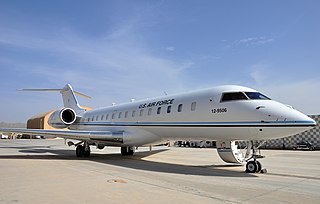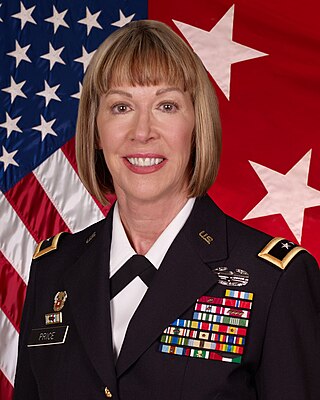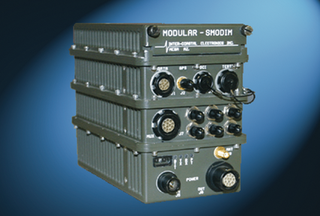
The Northrop Grumman E-8 Joint Surveillance Target Attack Radar System is a retired United States Air Force (USAF) airborne ground surveillance, battle management and command and control aircraft. It tracks ground vehicles and some aircraft, collects imagery, and relays tactical pictures to ground and air theater commanders. The aircraft was operated by both active duty USAF and Air National Guard units and also carried specially trained U.S. Army personnel as additional flight crew until its retirement in 2023.

ISTAR stands for intelligence, surveillance, target acquisition, and reconnaissance. In its macroscopic sense, ISTAR is a practice that links several battlefield functions together to assist a combat force in employing its sensors and managing the information they gather.

Future Combat Systems (FCS) was the United States Army's principal modernization program from 2003 to early 2009. Formally launched in 2003, FCS was envisioned to create new brigades equipped with new manned and unmanned vehicles linked by an unprecedented fast and flexible battlefield network. The U.S. Army claimed it was their "most ambitious and far-reaching modernization" program since World War II. Between 1995 and 2009, $32 billion was expended on programs such as this, "with little to show for it".
The Army Battle Command System (ABCS) is a digital Command, Control, Communications, Computers and Intelligence (C4I) system for the US Army. It includes a mix of fixed/semi-fixed and mobile networks. It is also designed for interoperability with US and Coalition C4I systems.

The Battlefield Airborne Communications Node (BACN) is a United States Air Force (USAF) airborne communications relay and gateway system carried by the unmanned EQ-4B and the manned Bombardier E-11A aircraft. BACN enables real-time information flow across the battlespace between similar and dissimilar tactical data link and voice systems through relay, bridging, and data translation in line-of-sight and beyond-line-of-sight situations. Its ability to translate between dissimilar communications systems allows them to interoperate without modification.
A program executive officer, or PEO, is one of a few key individuals in the United States military acquisition process. As can be seen from the examples below, a program executive officer may be responsible for a specific program, or for an entire portfolio of similar programs.

Blue force tracking is a United States military term for a GPS-enabled capability that provides military commanders and forces with location information about friendly military forces. In NATO military symbology, blue typically denotes friendly forces. The capability provides a common picture of the location of friendly forces and therefore is referred to as the blue force tracker. When all capitalized, the term refers to a specific defense contractors' system, but the capability is found in many military and civilian mobile apps.

The Project Manager Force Battle Command Brigade and Below is a component of the Program Executive Office Command Control and Communications Tactical Special Projects Office in the United States Army. The phrase "brigade and below" in the name refers to the fact that operations and communications within these smaller Army units are shifting to a digital integration.

Neil Gilbert Siegel is an American computer scientist, systems engineer, and engineer, known for his development of many key systems for the United States military, including the Blue-Force Tracking system, the U.S. Army's first unmanned air vehicle system, and the US Army forward-area air defense system. Several of his inventions also found their way into consumer products, such as hand-held devices whose map displays automatically orient themselves to align with the real-world's cardinal points.

Battle command (BC) is the discipline of visualizing, describing, directing, and leading forces in operations against a hostile, thinking, and adaptive enemy. Battle command applies leadership to translate decision into actions, by synchronizing forces and warfighting functions in time, space, and purpose, to accomplish missions. Battle command refers both to processes triggered by commanders and executed by soldiers and to the system of systems (SoS) that directly enables those processes.

PM WIN-T is a component of Program Executive Office Command, Control and Communications-Tactical in the United States Army. PM WIN-T has been absorbed into PM Tactical Networks as Product Manager for Mission Networks.

The BCT network is a layered system of interconnected computers and software, radios, and sensors within the Brigade Combat Team (BCT) designed to increase survivability and strategy on a battlefield where units can communicate internally instead of through a central command. The BCT Network allows for a more efficient use of communication and a possibility to plug combined-arms warfare into the network for better communication.

Nickolas G. "Nick" Justice is a U.S. Army major general who commanded the United States Army Research, Development and Engineering Command and Aberdeen Proving Ground, Maryland.

N. Lee S. Price is a retired United States Army officer who last served as the Program Executive Officer for the United States Army's Program Executive Office, Command Control Communications-Tactical, headquartered at Aberdeen Proving Ground.

The AN/TPS-80 Ground/Air Task Oriented Radar (G/ATOR) is the United States Marine Corps next-generation Air Surveillance/Air Defense and Air Traffic Control (ATC) Radar. The mobile active electronically scanned array radar system is currently being developed by Northrop Grumman and was expected to reach initial operating capability in August 2016.

Project Manager Mission Command is a component of the Program Executive Office Command, Control, and Communications-Tactical within the United States Army. PM MC is responsible for the development, deployment, and maintenance of integrated Mission Command software capabilities for the Army and Joint forces. The project manager ensures efficient fielding, effective training, and professional support for tactical and other unit types. PM MC's product lines cover the areas of maneuver, fires, sustainment, and infrastructure.

The Smart Onboard Data Interface Module (SMODIM) is an integrated device once used by the United States Army and foreign militaries for live simulated weapons training on military platforms. The SMODIM was the primary component of the Longbow Apache Tactical Engagement Simulation System that provides weapons systems training and collective Force-on-Force live training participation.
The Global Combat Support System (GCSS) is a web-based automated logistics system, for use by U.S. Department of Defense logistics specialists. This tool aids the specialists as they plan, and provide for, the materiel requirements for combat support.
The transformation of the United States Army is part of a strategy using Multi-Domain Operations (MDO). In 2019, the planning was for Large Scale ground Combat Operations at echelons above the brigade combat team. Multi-Domain Task Forces operate in a combatant commander's theater.
The US Army's Integrated Tactical Network (ITN) "is not a new or separate network but rather a concept"—PEO C3T. Avoid overspecifying the requirements for Integrated Tactical Network Information Systems Initial Capabilities Document. Instead, meet operational needs, such as interoperability with other networks, and release ITN capabilities incrementally.

















